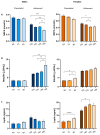Plasma Non-Esterified Fatty Acid Levels Throughout Childhood and Its Relationship with Leptin Levels in Children
- PMID: 39685744
- PMCID: PMC11642385
- DOI: 10.3390/jcm13237286
Plasma Non-Esterified Fatty Acid Levels Throughout Childhood and Its Relationship with Leptin Levels in Children
Abstract
Background/Objective: The relationship of non-esterified fatty acid (NEFA) levels with obesity and obesity-related alterations shows age-dependent variability in children. Leptin, with an important role in energy homeostasis and lipid metabolism, may be related to NEFA levels throughout the first decades of life. This cross-sectional study aims to analyse plasma NEFA levels in children of different ages and evaluate the relationship of leptin with NEFA levels depending on age. Methods: The study sample included 818 prepubertal children (age 6-8 years) and 762 adolescents (age 13-16 years). NEFA levels were measured using the Wako NEFA-C kit. Insulin and leptin levels were determined by IRMA and ELISA, respectively, using commercial kits. Results: The results of the study were found to show that NEFA levels were significantly higher (p < 0.001) in prepubertal children than in children aged 13 to 16 years (0.68 ± 0.3 mmol/L vs. 0.42 ± 0.2 mmol/L, respectively, in males; 0.71 ± 0.3 mmol/L vs. 0.44 ± 0.2 mmol/L, respectively, in females), showing a progressive decrease according to years of life in this cohort of adolescent in both sexes. Leptin and insulin correlated negatively with NEFA levels in younger children but not in older participants. The negative association between NEFA levels and leptin occurring in prepubertal children remained significant when adjusting for insulin. Conclusions: Besides reporting that NEFA levels decrease between the prepubertal age and adolescence, our findings indicate that, in children aged 6-8 years, leptin is associated with NEFA levels, independently of insulin. However, this relationship is not present in older children. Further studies analysing these associations according to pubertal status would be useful to deepen our understand of these findings.
Keywords: free fatty acids; insulin; obesity; paediatric population.
Conflict of interest statement
The authors declare no conflict of interest.
Figures



References
Grants and funding
LinkOut - more resources
Full Text Sources

